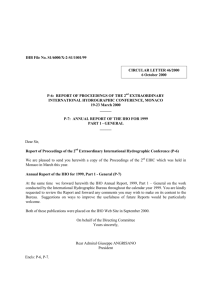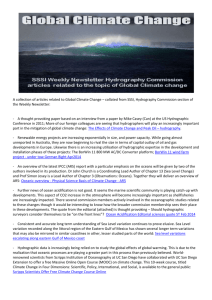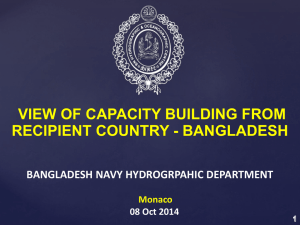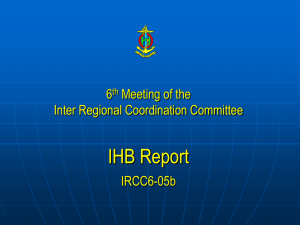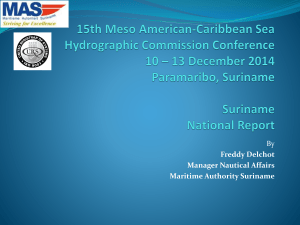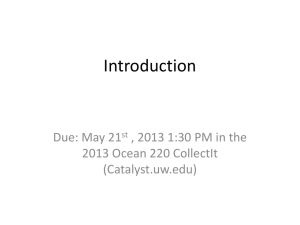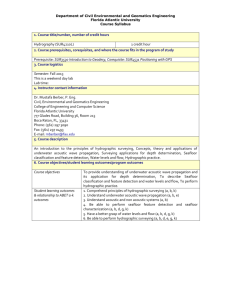04i_unit_presentation
advertisement
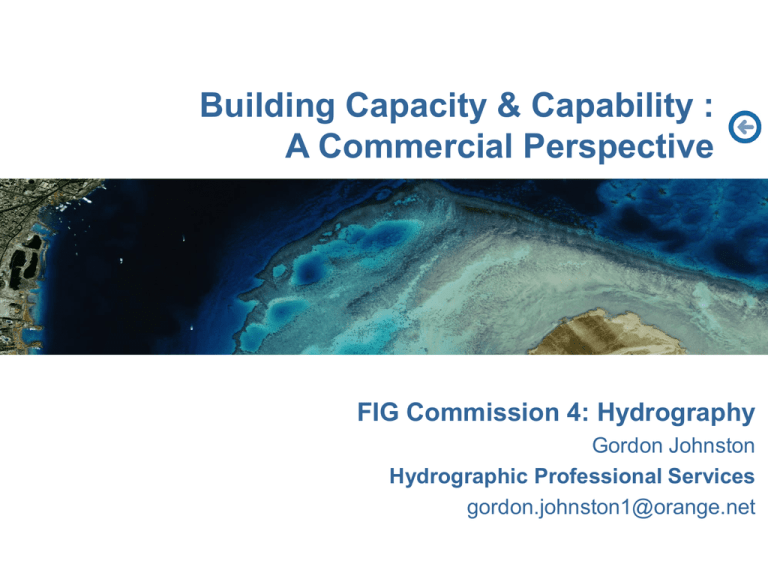
Building Capacity & Capability : A Commercial Perspective FIG Commission 4: Hydrography Gordon Johnston Hydrographic Professional Services gordon.johnston1@orange.net OVERVIEW INTRODUCTION Part 1: Building Long Term Capability FIG Building Capacity and a Hydrographic Capability Setting the Commercial scene Experiences from the Commercial Industry Influencing Parameters in attracting commercial industry to Hydrography Thoughts for Building Capacity Summary Part 2: The Economic Benefits of Hydrography Starting Point: Capacity Building is Possible 2 What is FIG? What is FIG? • FIG: The Federation Internationale de Geometrics is the top level Non Government Organisation (NGO) for surveyors. It is an umbrella organisation for national surveying institutions and groups. • FIG links over 100 National bodies in areas such as Standards of Competence, Technical Standards, policy and legislative reviews. • As many national NGOs represent individuals in their chosen profession, such as Land or Hydrographic surveying, it means that FIG ultimately represents the individual surveyor, not their commercial company or national surveying organisation. • • 4 E.g. Individual links to APSG, American Petroleum Survey Group. FIG has a small central directorate of 3/4 people and functions largely on the sponsorship of national organisations who take turns in holding the presidency of the FIG. This is renewed every four years at the main FIG Conference. There are 9 Technical Commissions that cover the areas of surveying. Hydrography is Commission 4. FIG Commission 4 • FIG Commission 4 (Comm. 4) • Commission 4 is Hydrography and as part of the 9 Technical Commissions it represents FIG at international level to link national bodies, often not the Hydrographic Office, in areas such as Standards of Competence, technical developments, training, policy and best practice. • Mr Adam Greenland (NZ) is the current chair of Comm. 4. At the 2006 FIG meeting in Munich, Germany, the new Chair of Commission 4, will be appointed, Mr Andrew Layzack (Canada). • It is Commission 4 that is represented on the International Advisory Board (IAB). This is agreed by way of bilateral Memoranda of Understanding (MOU). • Commission 4 recognises the importance of the continued development of individuals and encourages national groups to co-operate in developing and sustaining skilled personnel. • Next Meeting: 5 Munich Germany, October 2006 The International Advisory Board The international Advisory Board on the Standards of Competence of Hydrographic Surveyors and Nautical Cartographers. Meets annually and consists of FIG (4), IHO (4) and ICA (2) members 6 The International Advisory Board Two prime functions: Review submitted courses (4-9 per annum) Update and Maintain Standards (IHO M-5, M-8) 7 The International Advisory Board The IAB recognises the importance of promoting Hydrographic courses. It further recognises that it is also important to encourage individuals. The role of the individual is a topic of its current strategic review. The IAB (& FIG): Encourage Hydrographic Surveying capability and competent individuals 8 Building Capacity BUILDING CAPACITY Building Sustainable Capacity Long term commitment of Sponsor Member State (MS), a Bank and Industry. Cooperative approach to the overall needs must allow gains by all but different expectations exist. How will the requirements be identified? S-55 plus IHO and Financial Standards? Plans may not require full commercial support in all cases but CB may be the secondary goal by some groups who can gain access to funding. Areas include: Education and Training Technical assistance with a Commitment to a number of years of infrastructure support Continuing development:- Coverage, personnel, products Data collection and Data Management Technological transfer 10 SETTING THE COMMERCIAL SCENE PRIVATE INDUSTRY: A disparate group of companies that undertake data collection and presentation: Not a united community. ORGANISATION: Several industry groups exist but FIG (Federation International Geometric) is most senior. Hydrography is Commission 4. Other informal groups of the Hydrographic Society and IMCA, the International Maritime Contractors' Association. ACTIVITIES: Inshore, shallow water engineering tasks through many variations to deepwater, long-range, route surveys. Part of the portfolio is the more traditional Hydrographic capability for safety of navigation tasks. The “Hunter Gatherers” of data. TECHNOLOGY: Varied and is not always the latest and so costs, quality and timescales differ. Assets may be hired or leased to fulfill the requirements, including the vessels. PROJECTS: Undertaken as specific contracts. Traditionally the relationship is as a Client and Contractor, much less often a Partnership. Consequently relatively short term. 11 The Commercial Scene 2 COMMERCE: Activities to gain some financial reward. Outgoings less than Income! RISK: A generally risk averse attitude is taken by commercial survey companies. They will not undertake projects with huge risk (in their assessment. This impacts on the type and quality of responses that may be received from an Invitation To Tender (or Request For Proposal). CONTRACTS: Many varied examples and versions exist for Hydrographic Survey work including lump sums, Time and Materials, Co-operative arrangements with shared risk and shared use of products etc CURRENT STATUS: The offshore Oil & Gas industry is very busy and the resources, especially personnel and vessels, are in short supply. Commercial rates are at a high and there are some long term (35 years) contracts. 12 THE COMMERCIAL SURVEY COMPANY THE COMMERCIAL SURVEY COMPANY The Organisational Structure The Market & Client Base The Process of gaining commercial work 14 A SURVEY COMPANY ORGANISATION 15 The Small Survey Organisation Director/ Survey Manager/ Sales & Marketing Field Survey Crew Party Chief Surveyor 16 Office Technical Support & Engineering Engineer Administration/ Accounting THE MAIN MARKET AREAS Hydrographic Surveys Safety of Navigation, Ports & HO’s Geophysical 'Site' Surveys - Shallow Hazards for E&P companies and Telecommunication companies Geotechnical Surveys Sampling, coring and analysis Oceanographic Observations- Water level and currents Construction Work Support to large Engineering projects especially during installation and confirmation of as-laid units for Engineering Groups LIDAR Surveys Shallow water reconnaissance, HO’s ROV Operations Associated with Engineering and Construction work as well as annual maintenance and inspection programmes for various activities. 17 THE MARKET SECTORS SECTOR VALUE Oil and Gas Submarine Telecommunication Cables Ports & Harbours Hydrographic Surveys Others (Defence*, Wind Farms, Engineering) * Commercial contracts not Military TOTAL 18 year 2000 2006 est. $221m $47.5m $182m $261m $22m $345m $30m $230m $340m $50m $685m $995m EXPERIENCES OF INDUSTRY PREVIOUS INITIATIVES AND EXPERIENCES Previous Initiatives experienced difficulties such as too high an expectation of what they are able to get and for how much money that would cost. Government agencies tend to talk to each other ☺ What is achievable and reasonable. Perhaps too much influence from academia and the equipment manufacturers’ sales teams. Short term goals don’t meet CB criteria. MS do not all appreciate the costs of data collection and the value of the data once acquired. Thus any lack of understanding suggests a greater need for education programs to continue. Industry should provide a solution to a problem, not just the survey data. Often the problems are wider than technical challenges to the survey itself so Industry is not always best able to support studies. Regional Hydrographic Commissions to date have not really played a visible role to Industry, however………. ☺? 20 COMMERCIAL EXPERIENCES Projects awarded for 1 year through to 5+ years: Restricts investment Size of project work varies but $500k to $30m+ Activity closely monitored by MS: Good, Short term & Specific Goals MS lacks resources to monitor: Less Good, Longer periods & often Incomplete goals MS that award their own surveys usually do so to increase data collection. This often meets a short term objective. Does not create ongoing capability or a sustainable capacity unless part of a strategy of outsourcing and technical development. MS that have limited infrastructure and contract commercial companies can gain data but not always the products for release. Commercial difficulties will impact severely on this type of project. Collaboration between a group of MS with a competent HO in support offers an efficient way to derive short term gains AND meet longer term goals. Specialist capability sought by MS in support of deep water activities. 21 COMMERCIAL EXPERIENCES Resources applied where it can make a difference is fundamental to developing trust and a relationship with the supporters of Hydrography 22 COMMERCIAL EXPERIENCES(2) Experiences: some hazards Too optimistic and ambitious a plan involving too many parameters and changes New technology Training developed Update large scale charts and large areas. Failure to recognise the risks and limitations Poor progress and late delivery of items Change in financial environment Commercial organisation reviews its business and commitment Withdraws from further activity 23 COMMERCIAL EXPERIENCES(3) Good Experiences: Short term specific goals stated by MS. E.g. deep water task, or area of survey for nautical charting improvement. Long term Contracts or at least a commitment to continue to offer annual contracts. This is typically as part of an HO strategy. If properly constructed will maintain good relationship with a commercial company. HO approves and appoints suitable QC and QA process. Industry have supplied both services and products to create a sustainable environment based on their experience. This needs added elements to secure technology transfer to the MS such as Training, an academic role, a wide range of use for the data. Collaboration between a group of MS with regional interests, funding, SoL interests or the environment. Summary: Agree, commit to, maintain & monitor a clear set of achievable goals. 24 INFLUENCING PARAMETERS AND TENDERING INFLUENCING PARAMETERS ON INDUSTRY Influencing Parameters in attracting commercial industry to Hydrography: Location of work (for data collection) Size of contract Period of contract Profitability Technical risk in meeting specifications Benefits in Personnel, Market Stable programme of work with investment opportunities Personnel: Must see organised structure and Continuing Development opportunities. Use Cat B/A then a Competency Scheme to measure value and progress. 26 SUSTAINING SERVICES Public-Private Partnerships can be created. Privatisation of a service could be considered. Concessions for operators and long term commitment could be linked. Examples of Port initiatives have demonstrated various ways in which the Stakeholders collaborate to create a win-win situation. There is no standard approach and model for Hydrographic services, however the World Bank produced a Port Reform Toolkit with useful guidance and strategies. See: http://www.worldbank.org/html/fpd/transport/ports/toolkit.htm 27 SOURCE OF THE SPECIFICATIONS Full Scope of Work with Detailed Specifications. Scope of Work with Specifications, but including opportunity to Offer Variations. Scope of Work Provided with Specifications to be Provided by Contractor. Specifications created by one of the following: Comprehensive dialogue with potential suppliers Reference to Academic centres of excellence Adoption of parameters claimed by equipment manufacturers Creation of Specifications from existing documentation Often the specific project timescales does not allow for extended bid preparation, variations and discussions to develop improved or amended specifications or clear investment strategy for the MS. 28 BID EVALUATION - PREPARATION The review process – Technical/commercial/management. Previous work, pricing and experience - review. Contractual limitations - liabilities, exceptions etc. Taxes, Bonds, Scheduling, Currency. Today Yesterday 29 PREPARATION OF THE COMMERCIAL BID Consideration of any bid constraints Assessment of client specifications - suitability, alternatives etc. Assessment of insurance implications Assessment of risk Pricing, including the provision of survey vessels Invoicing program (credit, disputes, variations etc.) 30 THE INSURANCE PROBLEM Who will be liable? For Salvage The Environment To Re-instate Op’s 31 PREPARATION OF THE TECHNICAL BID Review of the Specifications stated: IHO, LINZ NOAA etc Consideration of methods: E/S, MBES, SSS etc. Availability of suitable equipment. Availability of skilled personnel: Data collectors, Processors and QC The influence of survey vessels and their suitability: A large commercial investment that must be suitable for the proposed works and operations. Previous work and experience - review & provide track records. 32 VARIATIONS The commercial importance of Variations. Reasons for Variations. The process for Variations - communication and agreement. 33 PRICING Direct Costs Indirect Costs Depreciation, Maintenance and Insurance Phased payments or scheduling The Profit Margin! 34 INFLUENCING CHALLENGES Observations: The contracts all offer different commercial terms and conditions. The timescales of the work vary. The technology required and, sometimes, specified is varied. The actual data collection criteria may be different. Associated and related data collection or survey activities may be competing with or influencing the project. Conclusion: There are not sufficient common standards to enable the Capacity Building initiative to be seen as an efficient process. Specifically history of development, timescales, funding, internal government processes and competition. 35 Member States 36 BUILDING CAPACITY Thoughts and Comments Projects need to be identified through some appropriate assessment. Is this ONLY an IHO/IMO task to determine who is the most needy? Well maybe but perhaps industry can provide a commercial perspective for gaining financial support. FIG & Industry can help in accessing funding organisations. Definitely build on previous US, Australian, French and UK work. Preparation of the Project requirements should involve both the MS and a supporting (Peer?) HO from a Regional Hydrographic Commission. Why? Improves the timescale of the process. Industry should be prepared to do more than collect data: Desk Study, Training, Equipment, Data Management. Why? Commitment Industry has resources and better utilisation of assets is always welcome. Industry will look to IHO & FIG to create the environment. Industry must see the HO’s or RHC’s (IHO) as useful groups to collaborate with on identifying opportunities. 38 Thoughts and Comments Standards for Assessment and defining Projects are required. Clear processes to describe the chain of events and get industry involved as early as possible. FIG offers access to experienced and professional resources. Competition will remain and even increase between industry and HO’s therefore a clear set of procedures and roles and responsibilities need to be set to guide MS, HO’s and Industry. Why? Essential to have a united front for Financial Support & Success. We must market Hydrography! 39 Thoughts and Comments IHO: Offers mainly Technical Assistance The IHO may be seen as too Bureaucratic and institutional by Industry The IHO may be seen as too Technical by MS. Funding The EDB, World Bank etc. have many projects. Hydrography could be part of many more of them than is currently the case. My experience is money is assigned to clear projects with clear outcomes. e.g. Cruise liner safety, port infrastructures. We must identify possible projects that Hydrography could get support with. Not necessarily the main Project Goal. E.g.Resource Exploitation The Environment: Navigation: Trade & Commerce: Recommendation: 40 Pollution, Species preservation, recreation. SOLAS V must be exploited. Shipping routes, ports & harbours building trade and reducing Insurance costs. Build a realistic Business Case Capacity Building 41 How to Develop a CB Program Cooperation between stakeholders should enable the case to fund a Hydrographic survey project to be developed more easily. The review must expand upon the safety of life case and include social, environmental, political and institutional benefits and gains. The problems requiring solutions represent GAINS that may not be related to Capacity Building. The IHO could provide guidelines on the type of Project structure and management (technical & project at least) in order to generate effective conditions for building capacity. IHO stewardship of the Capacity Building selection process and possibly the funding process also would facilitate the aim of collecting data and rendering charts etc. Marketing Hydrography and identifying possible projects in a wider context will aid this and MS HO’s and Industry should not see each other as the competitor. 42 How to Develop a Program 2 The Capacity Building initiative will take Time Must identify ways to speed up the process and deliver against expectations of Organisations, MS, IHO, Funding groups and industry. Technical and commercial liaison must be supported by a Financial element to gain funding and awarding work to suitable organisations or companies with clear incentives for results. Industry is NOT a White Knight Realistic goals and benefits must be identified and included in any proposals to 3rd party groups. Capacity Building will not happen for it’s own sake. Usually because the data is not recognised as being important enough. Industry is NOT a threat We (Industry) must also find partners and act in a cooperative nature through adaptation and evolving to meet needs. 43 Applications throughout the Survey Chain The Survey market can be looked at as a chain or sequence of events. Estimated value $500m pa To make progress with Capacity Building the prime areas of expertise should be recognised and activity focussed. Value Chain Hydrographic Surveys Planning Funding Funding Data Data Collection Collection QC QC Data Management HO’s Survey Companies IHO Stewardship Team Market Growth : up to 10% of annual commercial activity $50m Industry can deploy technologies and develop certain alliances with Standards 44 Applications throughout the Survey Chain The value chain could be developed to more focus on the strengths of the stakeholders Value Chain Hydrographic Surveys Planning Funding Funding Data Data Collection Collection QC QC Data Management HO’s Survey Companies IHO Stewardship Team To develop Capacity Building all participants need to gain something Standards, education and cooperation projects must continue 45 Summary (1) The IHO can take a firm and positive role to lead a true initiative that will make a difference. The IHO could unite the commercial sector by developing Standards and guidelines for adoption in supporting less well developed MS to meet their SOLAS V obligations. Industry will find ways to support the initiative and lobby for funding. IHO can help by being realistic and developing a relationship with the commercial sector. Achievable aims and common goals must be defined and stated. To create a Sustainable Capacity Building program the stakeholders must be represented when forming plans and from the commercial perspective….. 46 Summary (1a) 47 Summary (2) Acknowledge the true cost of data collection surveys. Maybe Charts are no longer the correct deliverable? Consider more innovative approaches to Capacity Building through Marine Highways, and data for ENC/MIS and spatial database use. Generate Terms & Conditions of contract to support investment and stability. This should be linked to an efficient review, tendering and award process to guide the MS and their Peer HO’s using proven models. Keep “In Touch” with reality = Industry and Funding groups. FIG is the nearest thing to a Commercial grouping of Industry that can, through it’s Commission 4 Work Groups, support and aid the IHO in developing Standards and building relationships. 48 Actions (1) IHO and RHC 1) Establish Strategy and set Timescales of goals. 2) Educate, lobby and encourage MS. 3) Develop KPI & Standards for Assessment. 4) Create Stewardship of CB programs and encourage RHC’s to cooperate in developing programs. 5) Gain much more access to Financial Expertise & support. Not just Technical support & advice. 6) IHO could support a Regional Funding Activist to access Banks and international agencies. 7) Continue with Industrial Liaison and create Case Studies to support claims for investment. Encourage the use of RHC events for dialogue with Industry. 49 Actions (2) Industry - FIG and Companies • Build relationships with RHCs. • Access Funding Groups to lobby the need to provide solutions to problems. • Identify short term opportunities and goals within the Capacity Building initiative to meet funding requirements. • Cooperate with academia and HO’s to develop capacity for the long term. • Industry is interested in follow-on activities for ports, construction etc. and should focus on that long term strategy. 50 Actions (3) Member States • Be active in RHCs. • Identify and secure sources of Funding in collaboration with IHO & Industry. • Identify realistic short term opportunities and goals within the Capacity Building initiative to meet funding requirements. • Create a strategy for cooperation with partners so that Hydrographic capacity is sustainable in the long term. • Industry is interested in follow-on activities for ports, construction, exploration etc. and so MS can focus on links to meet the long term strategy. 51 Conclusion Capacity Building is Possible ☺ IHO is a key. So too are you the Member States and your HO focal point. Industry and Academia each can play a key role. Don’t be afraid to Outsource! Sustainable Capacity Building is also possible☺☺ Benefits for individuals, organisations and nations exist as long as the approach is a team effort to gain support and identify each of our interests. 52 Part 2: The Economic Benefits of Hydrographic Products and Services Economic Benefits and Case Studies OVERVIEW INTRODUCTION Part 1: Building Long Term Capability Part 2: The Economic Benefits of Hydrography What are the Products and Services? Who are the Stakeholders? What has been the experiences to date? What now? Starting Point: There is no clear case for Hydrography based upon Chart sales and Products alone. Previously we heard how Chile and Croatia generate only 18% and 40% respectively of their costs through sales. 55 MS HO Products and Services The traditional products and Services of a typical MS HO are considered to be: Paper Charts, Electronic Charts, Notice to Mariners, Tides and tidal streams, Sailing directions etc Various MS are now expanding and developing services to provide information to non navigation users through a national spatial data infrastructure. If the full economic benefit of Hydrographic services is to be realised it is important to extend the provision of services across as many economic sectors as possible. This requires that the various Stakeholders are identified and they become engaged in the use of data. The duty of care imposed upon Hydrographic Offices requires the use of appropriate modern equipment. 56 Stakeholder Benefits Who exactly are the Stakeholders? These may include: Commercial Shipping: Cruise Operators & Freighters Ports & Harbours: Customs & Excise, import and export businesses, road, rail and freight infrastructure and those that rely upon trade. Environmental groups Nearshore fish farming: Permitting, management and control Coastal Zone Managers and Protection of the marine environment: effects and impacts Fishing, Tourism and desalination. Hydrographic information facilitates: delineation, establishment, administration and sustainable development of national maritime, coastal zones and resources. SOLAS requires contracting MS to provide Hydrographic services 57 Stakeholders: Commercial Shipping The average growth in the region was 5.5+% GDP over the 2000 2005 period. MS that operate "Open Registry" must maintain their reputation. The value of trade by ship is increasing at 5+% per annum. The region of South, Central America and the Caribbean account for less than 4% of world's vessels (1000 Grt+). With many island states, the majority of trade is by sea (over 95%) and by foreign vessels. Vessel size is limited by the environment however the world trend is to scale up the vessels and reduce the unit cost of cargo. The region is a net importer of goods with: $346bn exports and $400bn exports. In addition their respective rates of growth are: exports 1.4% whilst imports 14.4% The area is dominated by the US economy and many trades, particularly in the Caribbean are to US ports. 58 Stakeholders: Commercial Shipping The average age of the fleet of Central American, South American and Caribbean states is over 19.7 years. cf the world 12.3 years. The investment in new vessels will create a greater need for hydrographic products and services: Larger dwt with longer hulls and deeper draughts = Dredging and charting services Faster, more efficient at loading/unloading = Suitable routes and management schemes Newer navigation and bridge systems = Accurate charting and navigation markers to compliment the GPS, AIS and other technologies. The majority of trade is by sea (95%) and by foreign vessels. There are only a few large carriers and they require suitable products & services to support their commercial plans. 59 Stakeholders: Passenger Cruises There is a huge dependence upon passenger Cruises: Worldwide over 11.5m passengers embark on cruises, of which over 8m are US citizens. Over 4.8m passengers depart Florida each year. Another 1m depart from the Gulf of Mexico US Passenger Cruises generate $32bn per annum of which $16bn is in indirect costs such as shore trips, flights, hotels etc. The top performing economies of the Caribbean rely upon tourism for their income: British Virgin Islands: 45% Cayman Islands: 70% Cruise Operators have taken upon themselves to have Hydrographic surveys carried out to ensure safe havens and anchorage in certain places. This income must be supported and encouraged. Hydrographic surveys could aid this important activity in the region. It is a GROWTH industry!! 60 Stakeholders: Ports and Harbours Hydrographic charts are an essential part of the MS transport infrastructure. Ports seek: Economic transportation by reduction in costs, easier routes and fuel and time. This can lead to insurance costs and claims reduced. Suitable anchoring zones close to Port. Commercial Operations: A large cargo vessel can cost approx. $1200 per hour. Competitive nature of the international trade routes with Ports at their hubs. Specialist Port services are required to attract larger vessels. Investment is key and MUST include safe passage, by hydrographic surveys, to ensure a sustainable capability. 61 Stakeholders - Ports and Harbours Case Study: Guyana The ports of Demerera and Berbice benefit from regular surveys that monitor the presence of fluid mud or "Sling-mud". Through repeated surveys vessels of 9m draft transit the delta area with only 6-7m of clear water, the rest being mud. This region should take note of others and the competition: At the 2001 Pan-African Ports Conference a declaration stated: The conference "Reaffirms the need for African states and sub regional economic groups to adopt concerted development policies on transport infrastructure in general, and ports in particular (ports handle 90% of the continent's trade), in view of their role as trade hubs" Such initiatives require sustained and modern Hydrographic services. 62 Stakeholders: Ports and Harbours The Ports act as a form of Hub for the transportation of goods. Ports need to be competitive. The growth in trade of a MS is directly linked to its maritime trade growth which in turn is influenced by the ability of Ports and Harbours. Freight costs represent over 10% of the value of goods. New container and inter-modal transportation developments need the basis of good hydrographic products and services. Reduced speed, or increased channel distances contribute to costs and a balance for the Port between improved passage and their maintenance costs needs to be achieved. 63 Stakeholder Investments: Ports and Harbours The Ports of South and Central America and the Caribbean do receive investment. In recent years: Brazil: Chile: Jamaica: Columbia: Brazil: Dominican Rep. Panama: $100+m for port development $110m for port development $10m port infrastructure & expansion works. $20m port works $800+m for development of inland waterways $290m port development works $600m port development works This investment must be supported by suitable survey and safe charting. 64 Stakeholders: Exploration Companies The African region is set to experience an increase of over 100% of subsea field developments in 2000 to 2005. The price of a barrel of oil is predicted to remain relatively high and some pundits have predicted $100 and as much as $300. The demand from the Far East continues to grow and major finds are less common. West Africa offers tremendous potential and should direct some of the revenue into the infrastructure to secure stability in the long term. For Hydrography this could be a direct link from the exploration and production activities to funding and supporting an HO capability. Now the interest is often in deep water (>300m) and therefore the products and services deemed of value are data sets including tides, currents, seabed topography and classification. Safe port and harbour facilities are very important as part of an infrastructure to support the 25 years of field production. 65 Stakeholders: Coastal Zone Managers The benefits to such a group of diverse users of data and information will be difficult to quantify and predict. Aggregate mineral extraction, the licence to develop fish farming and recreational facilities all require analysis to evaluate their impact on the environment and the local coastal area. Fishing activity often support local and national requirements but may be seasonal or prone to weather conditions. The safe passage, avoidance of hazards and threats to equipment as well as ease of landing catches must be linked to the Hydrographic products and services. The ease and distribution of Hydrographic information supports and aids these activities. Policy decision making processes can be confident of reliable inputs and less risk of poor implementations of strategy. 66 Stakeholders: Coastal & Territorial Seas The benefits to a MS of establishing and maintaining its territorial waters is fundamental to many of their citizens who rely upon safe passage, resourceful maritime seas and clear demarcation of limits and boundaries. In the Caribbean region and central and south America there have been a number of boundary disputes and challenges over the years. Disputes such as these can indicate that a nation does consider its maritime area as a strategic and commercial asset. Hydrography of course can support claims to territory by providing the all important survey information. This information should provide the basis for economic and commercial management of the maritime resource. 67 Stakeholders: Environmental Groups The importance of good quality, reliable and up to date Hydrographic information is a benefit to many environmental groups who rely upon this for strategic decisions. Various groups and organisations exist and the role of an HO is to empower and engage these authorities and organisations such that they use and value the information. Heritage groups with interests in archaeology, ship wrecks and the increasing need for waste management. The following is an extract from the Irish National Seabed Survey that commenced in 2000 and engaged in many groups with interests in marine and maritime information. 68 Stakeholders: Benefits and Customers The Irish National Seabed Survey states: "Virtually everyone involved in offshore activity will benefit from the results of this survey - policy makers, industry, engineering, geologists, biologists, research groups e.g. universities, heritage and protection. The maps will be useful in indicating the likely distribution, extent and location of potential mineral deposits (e.g. sands, gravels, gas hydrates) or potential hydrocarbon indicators. Fish habitats are often controlled by the nature of the seabed, and fishery interests seek information which makes fishing more economical while minimising the environmental impacts of trawling. In addition, baseline maps will assist in studying natural hazards as well as global environmental changes. Ocean engineering including cable and pipeline laying (e.g. telecommunications or power), and the siting of rigs and offshore installations also will benefit greatly from the results of the survey. Survey results will also be useful to those with interests in offshore aquaculture, navigation, deep sea cold water corals, heritage (including shipwreck identification), renewable energy developments and waste management." See 69 http://www.gsiseabed.ie and Irish National Seabed Survey Economic Uses of Hydrographic Products In summary many traditional users require up to date and reliable information for decision making purposes. Safe passage of cargo and passenger vessels. Commercial fishing including policing fishing zones. Recreational fishing and sailing including power boats. Mineral exploitation. Pollution Prevention. Safety of Life at Sea. Establishing and policing Exclusive Economic Zones. Asserting any claims to territory. Scientific research. Complying with International Obligations 70 Supplementary Economic Benefits Commercial fisheries sector resource location, economic zone maintenance, regulatory enforcement and reduced equipment losses. Definition and maintenance of sovereign zones. Enhanced coastal resource management. Assistance in the exploration of minerals. Improved emergency response. Contributions to national defence. Assistance to recreational boating, fishing and leisure. Overall environmental protection. NOTE: Overall it should be recognised that national Hydrographic programmes are regarded as being a "Public Good". The necessary level of services will therefore not be supplied by market forces alone. 71 Secondary Stakeholder benefits Each MS should evaluate and consider the potential for new markets and uses of the data and information. Commercial markets offer greater potential reward than standard military and defence orientated requirements. The potential to develop new markets in response to global demands such as Tourism Recreational water activities Aquaculture Mineral extraction Economic social and legislative benefits? How do we establish and define these???? 72 Economic Benefits An APEC Transportation Working Group Study (2002) recommends a nation to: 1. Carry out an audit of Hydrographic department to identify areas that need attention. 2. Carry out an economic analysis for the hydrographic requirements. (a model was developed to undertake this type of activity) 3. Ensure that the necessary development of the Hydrographic Office is included in any national or ministerial development plans. 4. Ensure five year plans exist to sustain national survey and charting. 5. Review Hydrographic work practices and improve cost effectiveness. 6. Review the institutional and co-ordination arrangements to assess the benefits of formal agreements. 73 National Challenges The UN undertook a study in 1989 and although relatively old indicates some institutional areas that need to be tackled: • • • Delays in processing permissions, clearances and accessing resources due to partner organisations (Customs, port authorities, government departments) Outdated procedures and inadequate human resources Foreign exchange problems in payment transactions These are important barriers that must be tackled in any strategic plan to address a sustainable capability or capacity. Hydrography & Hydrographic Surveying is no exception. 74 CASE STUDIES Lets review a couple of examples where the benefits of the Hydrographic effort has been reviewed and where co-operation, collaboration and investment has made an impact on the Hydrographic status. Australia Bangladesh Canada PNG Philippines Red Sea Area United States 75 CASE STUDIES: - Australia The Royal Australian Navy's 1992 study to assess the economic benefits of the Australian Hydrographic Programme. Exact figures on economic benefit were not possible. Benefits that flow from the Hydrographic Programme are such that "there can be no doubt they are very large". Including efficient passage of shipping, protection of the environment, safety of life at sea and the management and exploitation of marine resources. To the nation efficient shipping is vital and suggests the initial investment to reduce transport costs shall create a benefit of 7x the investment. The advent of GPS requires that existing charting must be updated to keep pace with accuracies and modern methods. "what is beyond reasonable doubt…..up-to-date charts has a benefit ..that greatly exceeds the cost". The Hydrographic Programme is a Public Good. The traditional naval activity should be reviewed given the wider benefits. 76 CASE STUDIES - Bangladesh Bangladesh received assistance from SHOM and its associate department NAVFCO (the French naval Company for Training and Advice). Over 20 countries have received support and assistance. The aim of the HYDROBANDLADESH project was to develop the Hydrographic capability and provide modern equipment to enable the creation of suitable Nautical Charts. Phase 1 Initial Training Supply of Equipment In-country technical assistance for support purposes This led to the completion of an up to date Nautical Chart (1997) Phase 2 Supply of GIS, systems and cartographic training Supply of resources for essential route surveys with Side Scan Sonars Modernisation of the Bangladesh Training School A small team to provide in-country training and technical assistance 77 CASE STUDIES: - Canada Canada undertook a review of the cost benefits of the Canadian Hydrographic Service (CHS) in 1992. The main economic sectors identified were Commercial Shipping, Fishing, Recreational Boating, National Defence, the Arctic and the Environment. The charts can be compared to roads and their use for transportation. Better roads (charts) = better, safer, quicker, cheaper transportation. The annual cost of the CHS were estimated to be in excess of $30m and on this basis the benefits to the above sectors were over $450m on the basis of the value of the charting. This gives a cost benefit ratio of 10/1. Other users and sectors not included would also be likely to benefit: Government agencies involved in coastal management, mineral exploration, construction engineers and ocean scientists. The cost benefit analysis does not evaluate any alternative costs for the replacement or alternative source of survey data (Defence, Public and Private charting). On review Benefits may be increased by expanding the user community, controlling costs and by reducing net costs. 78 CASE STUDIES: - Canada On review of the Study a number of points may be raised. Benefits may be increased by expanding the user community, controlling costs and by reducing net costs. Expanding benefits: increase the user community through better access to the information and products. Also collect different data sets. Controlling costs: a sustainable Hydrographic capability must manage and control costs in line with agreed budgets and long term targets. Reducing costs: the Net costs could be reduced if federal and government departments and agencies collaborated and co-operated and International agreements were established. 79 CASE STUDIES: - Indonesia The survey and definition of the Indonesian coastline Equip 3 survey vessels with modern systems Install and monitor 25 tidal stations Install and operate a real time DGPS service The establishment of a National Marine Resource Database Involving 3 survey vessels, Airborne Laser systems, 90 expatriates in the processing Centre and on the vessels this was an ambitious plan. Caution should be taken with such ambitious plans to ensure that the funding is secured and that all parties are committed to the goals. Late delivery of products and poor cost control or management must be avoided. The reputation for good co-operation and of successful outsourcing ventures is important for Hydrography. 80 CASE STUDIES: - Philippines A Study for the APEC Transportation Working Group "An Analysis of the Economic Benefits of the Provision of Hydrographic Services in the APEC Region" in 2002 offered some insights: The issue of the incomplete status of a number of APEC MS surveying and charting. The entire Hydrographic service costs may be justified from the benefits accruing by one market sector: Commercial Shipping. The analysis method used Commercial Shipping and deduced that the current expenditure of $3.5m could be increased to $5.9m and the return on revenues will be still be at least 12%. The analysis model can be adopted for other MS to evaluate and assess their cost to benefit ratio. The Philippines is an Archipelagic state and therefore experiences a considerable level of shipping which coastal West African states may not. The model should be adjusted to cater for the other market sectors. 81 CASE STUDIES: - Red Sea Area An example of international co-operation by several MS and the "stewardship" of the Hydrographic programme by an external HO. The UKHO supplied expertise and guidance in the assessment and the setting of priorities. Also in setting the specifications and assessing the tendered proposals. Data collection was awarded via a open contracting process. A commercial company was appointed and completed the survey. This project demonstrated the positive collaboration of several MS Stakeholders in a data collection programme and the assistance of a leading HO to guide and advise in the process. ☺ 82 Summary Most economies have only small numbers of skilled and experienced survey and cartographic personnel. This shortage limits many Member States in establishing HO's. Limits HO's in completing their tasks on schedule. Several economies are improving the cost effectiveness of Hydrographic services through technology, utilisation of vessels and outsourcing. Co-operation within regions are producing benefits in these areas. Increased regional co-operation should therefore be considered where it is practical. 83 Summary There is a lack of experienced personnel Large costs are associated with Hydrographic services Material resources are often in very limited supply but investment in new systems and technologies represent high quality. Outsourcing represents a potential solution to the above issues and should be evaluated as a partial if not complete solution in certain tasks. Co-operation on an international basis is also recognised as being of importance. FIG Commission 4 is working to support and engage Stakeholders in Hydrographic activities. Summary: Improved cost effective use of resources and the sustained need to complete Hydrographic surveys must be used to convince fund-holders to invest. Products may be achieved as well as developing a sustainable Hydrographic capability. 84 REFERENCES UNACTD Reports: Various UN Maritime Transport Reviews 2000, 2002, 2003 Douglas Westwood and Associates. Journal of Transport Economics and Policy, 1997. NOAA private correspondence. APEC Study: The Analysis of the Economic Benefits of the provision of Hydrographic Services, 2001. Inter and External Trade of EU Monthly Statistics, 2004 & 2005 Shipping News Ports and Harbours Container News Pictures Managed by PICASA2: http://www.google.co.uk/intl/en/options & Picasa Powerpoint by Bill Gates 85 REFERENCES UNACTD Reports: Various UN Maritime Trade Reports 2000, 2003 Douglas Westwood and Associates. Journal of Transport Economics and Policy, 1997. NOAA private correspondence. APEC Study: The Analysis of the Economic Benefits of the provision of Hydrographic Services, 2001. Inter and External Trade of EU Monthly Statistics, 2004 & 2005 Shipping News Ports and Harbours Container News Pictures Managed by PICASA Visit url = 86 http://www.google.co.uk/intl/en/options then scroll down to Google Tools, Picasa Comments How many submissions are actually being presented Hydrographic content is low How to connect at a very early stage Access Insurance companies 87
